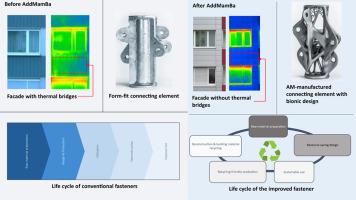From construction for construction: Additive manufacturing with gas-atomized recycled steel scrap
引用次数: 0
Abstract
Climate change and energy scarcity, as well as changing socio-demographic structures and new user needs, drive major changes in the design, construction, and operation of buildings towards sustainability. As the building sector accounts for 35% of global energy consumption and 38% of global CO2 emissions, the energy-efficient and sustainable design and maintenance of buildings will be an effective lever for creating sustainable living conditions in the future. The use of recycled materials in construction can reduce CO2 emissions and ensure a circu`lar economy. In this work, a proof of concept is presented for additive manufacturing by laser powder bed fusion (PBF-LB/M) of metal powder obtained by gas atomization of recycled steel from demolished buildings. From the atomization of approximately 50 kg of steel scrap, 27.8 kg of particles finer than 90 μm were obtained, whereas particles ranging between 90 μm and 315 μm accounted for 14.1 kg. The samples made from the recycled powder had a relative density of 99.9%, no porosity and excellent mechanical properties. The average tensile strength of the produced material was 808 MPa, whereas the average yield strength was 716.4 MPa. These results demonstrate the feasibility and efficiency of using gas atomized recycled steel scrap for additive manufacturing, providing high-quality materials with excellent mechanical properties suitable for construction applications.

从建筑到建筑:用气体雾化回收废钢进行增材制造
气候变化和能源短缺,以及不断变化的社会人口结构和新的用户需求,推动了建筑设计、建造和运营的重大变化,以实现可持续发展。由于建筑行业占全球能源消耗的35%和全球二氧化碳排放量的38%,节能和可持续的建筑设计和维护将成为未来创造可持续生活条件的有效杠杆。在建筑中使用回收材料可以减少二氧化碳排放,确保循环经济。在这项工作中,提出了激光粉末床熔融(PBF-LB/M)增材制造的概念证明,该增材制造是由拆除建筑物的回收钢的气体雾化获得的金属粉末。通过雾化约50 kg的废钢,获得了27.8 kg小于90 μm的颗粒,而90 μm至315 μm之间的颗粒占14.1 kg。回收粉末制备的样品相对密度为99.9%,无孔隙率,力学性能优良。所得材料的平均抗拉强度为808 MPa,平均屈服强度为716.4 MPa。这些结果证明了利用气体雾化回收废钢进行增材制造的可行性和效率,为建筑应用提供了具有优异力学性能的高质量材料。
本文章由计算机程序翻译,如有差异,请以英文原文为准。
求助全文
约1分钟内获得全文
求助全文

 求助内容:
求助内容: 应助结果提醒方式:
应助结果提醒方式:


